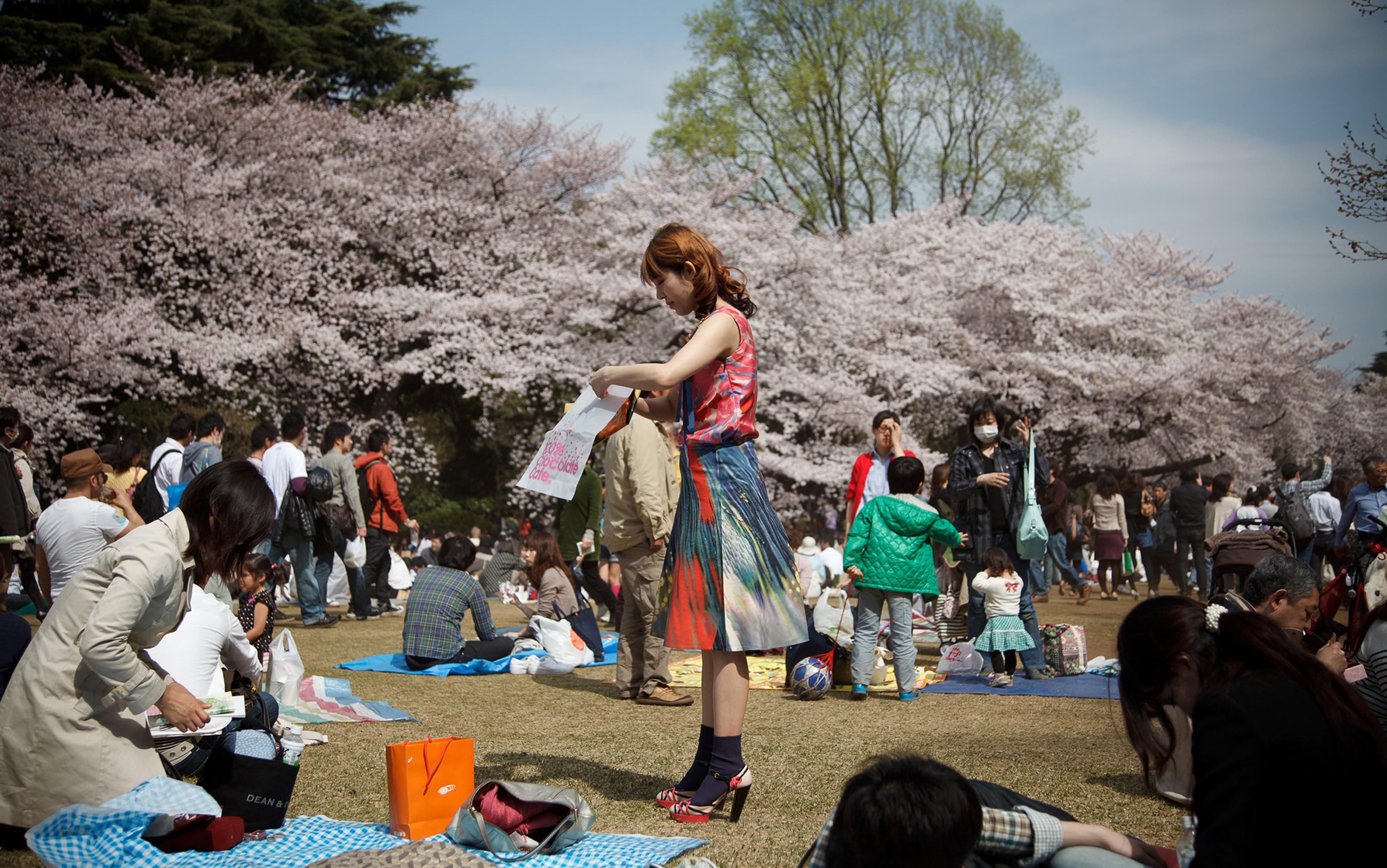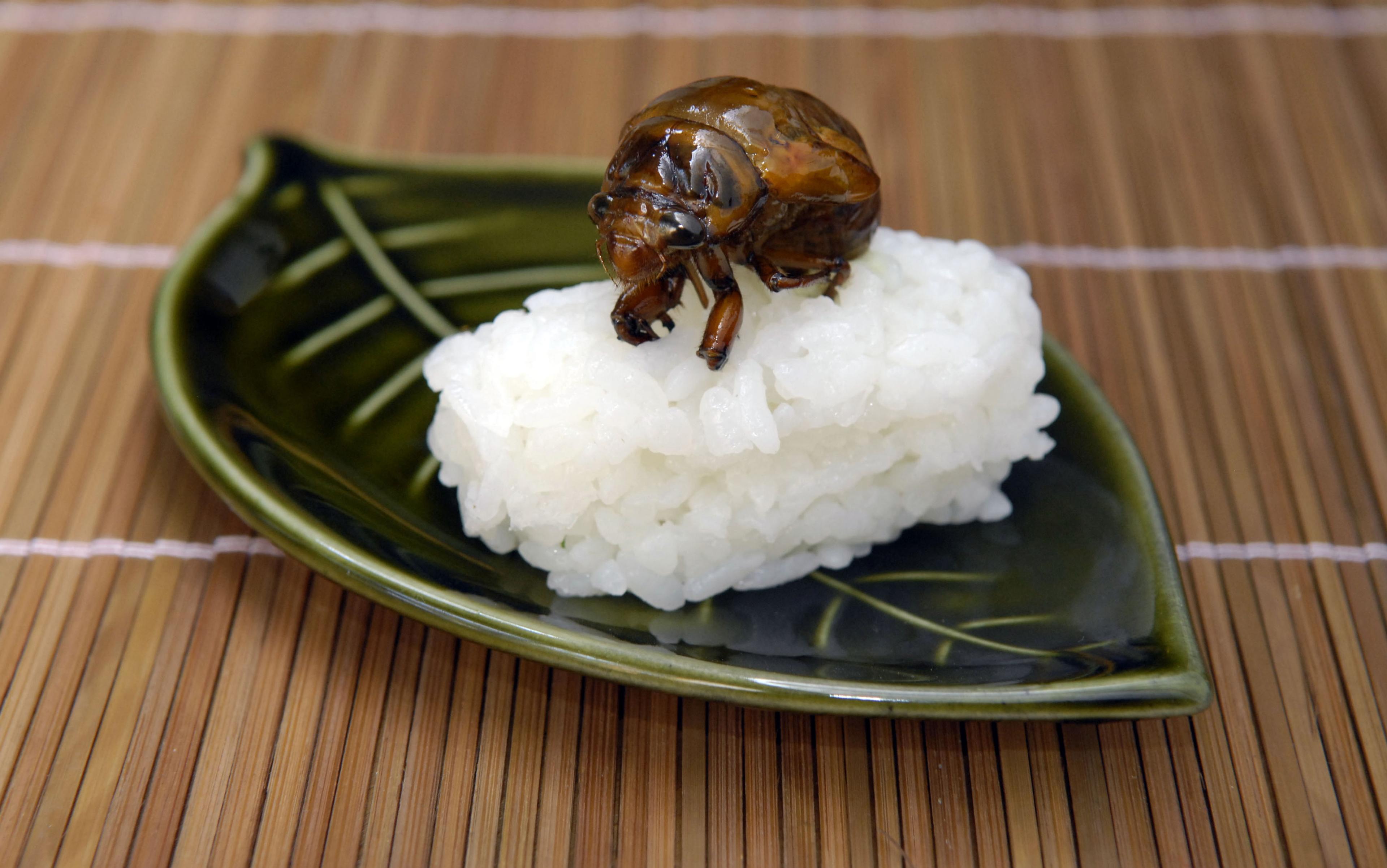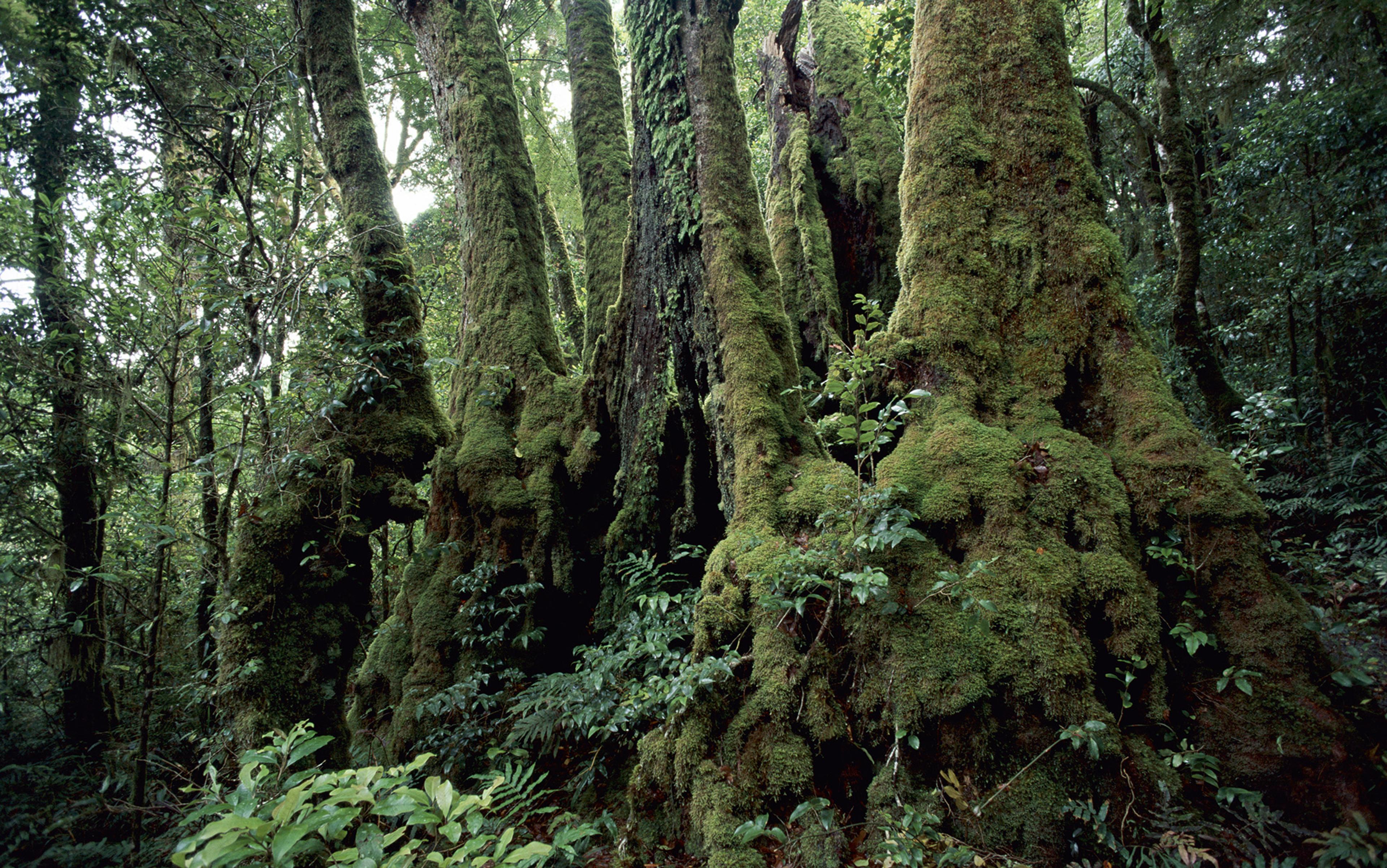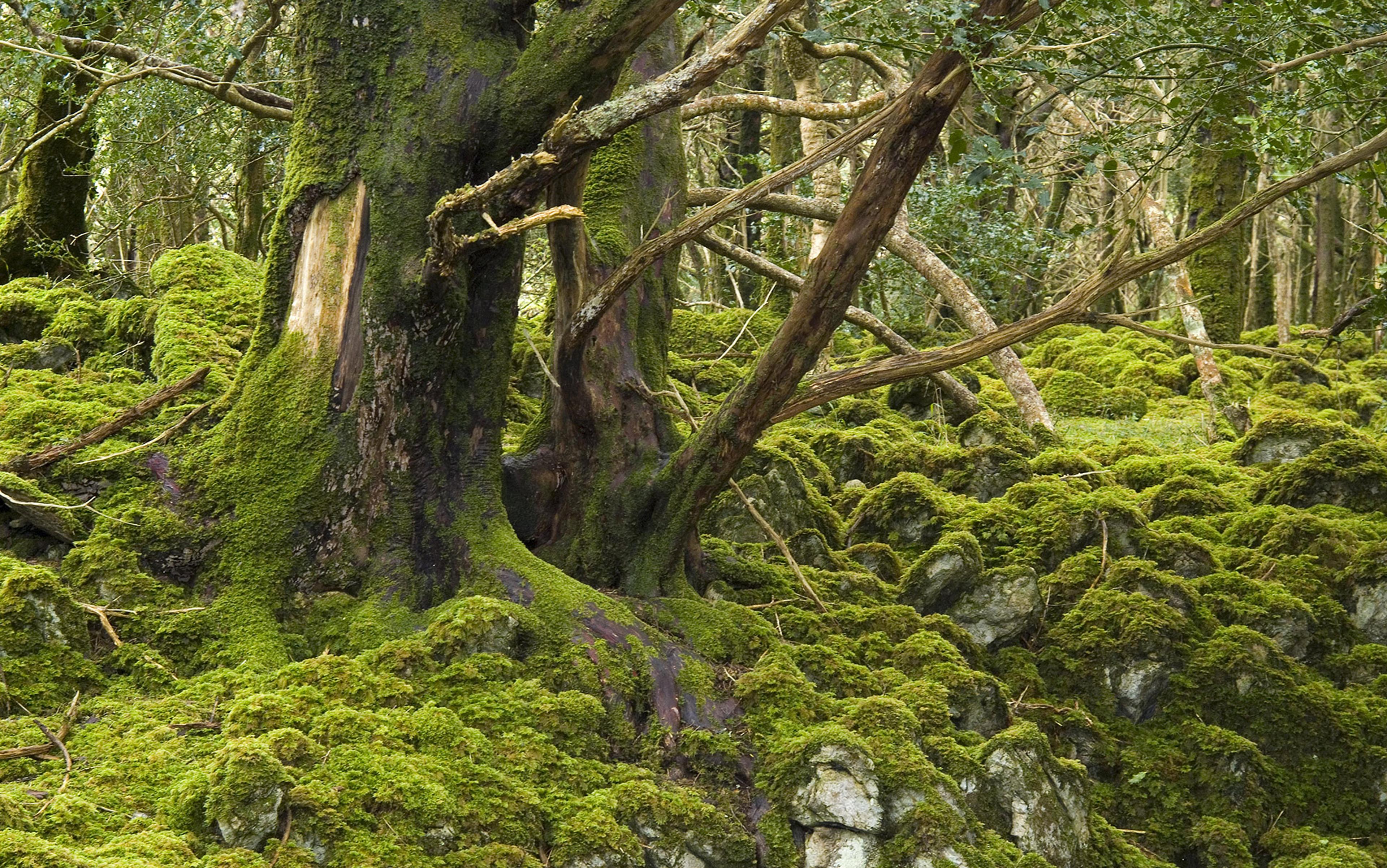It is peak sakura — the short, spring season of cherry-tree flowering that so besots Japan. In Ueno Park in Tokyo, falling blossoms settle over the sleeping salarymen, recumbent on tarpaulins with traffic masks yanked down around their necks. Curtains of petals draw open and closed in the wind around huddled teenagers. The flowers land on bitumen and bare soil, sometimes drifting into the open food containers of gathered observers. A distracted child places a piece of yellow eel, festooned with sakura, into her mouth.
For all their abundance, these branches are more likely to produce the candied maraschino cherries used to trim cocktails than the grocer’s fruit with which we are familiar. Japan’s urban cherries are ornamental, neutered cousins of orchard varieties. Planted to mark out places or events of note, some of the trees are thought to be more than 1,000 years old. Despite their lack of edible fruit, for two to three weeks in late March or early April, the city’s cherries become the most important trees in Japan. The nation’s climatic range triggers a staggered cherry flowering — a ‘blossom front’ that is monitored by the Japanese tourism agency as it sweeps up from Fukuoka, through Tokyo and north towards Sapporo. The cherries, and late, slow-moving plum flowers, jostle as they race around the Japanese Alps (cold snaps advantage the plum buds). When the sprays of blossom finally break open through the capital, their momentum is as forceful as floodwaters returning. The cherries’ high, white foam pours through avenues that lead to shrines, into graveyards, over public lands, and then to the brink of rivers and lakes where great canopies of petals spread above koi fish the size of corncobs.
During sakura, families and other groups, from workplaces or social clubs, assemble to celebrate a tradition known as hanami: flower-viewing picnics. These picnics first flourished in the Heian period, and are featured in the 11th-century courtly novel The Tale of Genji. When the hanami are in full swing, it can seem as if Ueno Park — one of Tokyo’s most popular locations for the celebration — has become the staging ground for a hundred small re‑enactments of scenes from A Midsummer Night’s Dream. Young women in short crinolines, chalk tights and dark Rococo-era dresses dart between the trees like insistent fairies. Some carry lace umbrellas (‘Goth Lolita Wear’ occupies a whole floor in a nearby department store). Junior wage-earners, sent to stake a patch for their superiors, set to dreaming in intimately vulnerable postures; their arms and legs flung out to indicate an intention to occupy more space. Paired shoes in a row belong to no one nearby. Nihonshu (saké) turns cheeks ruddy and friends garrulous.
Why talk of these common and decorative trees, when icebergs, polar bears, a dozen small types of amphibian and old-growth forests face the real possibility of extinction?
As the sun sets, the mood of enchantment reveals other themes: metamorphosis and attraction. Flash cameras twig at the edge of perception all through the night. The shots later come to colonise social media — sakura, stark and fibrous against the black sky. The flowers are extended electronically, long after they have withered, dropped, and ceased to be.
Gazing into the throats of flowers is surely one of the most trite, and universal, acts of environmental appreciation. From hand-picked posies displayed on a mantelpiece to the questing of the German Romantics for the impossible blue flower — a symbol of inspiration for the 18th-century poet Novalis — flowers induce an apparently effortless contemplation of aesthetic beauty in nature. Yet, for all the stock wonder of cherries crowned in blossom, contemporary Western environmentalism has an uneasy relationship with notions of the beautiful.
Political environmentalism has learnt to take a functional view of nature, turning a blind eye to cultural values such as beauty and to aesthetic practices such as hanami. In striving to establish an impartial, globally consistent means of gauging nature’s value, local forms of environmental imagination have been relegated to the work of poets. Nature is viewed as systemic and quantifiable, neither mysterious nor resplendent. In an overburdened world, this is how we have come to debate the comparative significance of habitats and organisms: as ecosystem services.
Perhaps, for environmental thought to be accepted in the political mainstream, it was always necessary to discard the drippy spiritualism of a former age and embrace the numbers game. Yet, something important has been lost in the exchange. Sidelining the environmental imagination — particularly its manifold local variations in different cultures — has narrowed the green movement. Better science, accountancy and leadership might well be essential to confronting the realities of our current environmental crises, but without developing a way to talk about the unreal aspects of our environmental relationships and our imagined attachments to natural phenomena, progress will only ever be tenuous. Ancient as it is, the Japanese tradition of sakura offers germane insight into this very contemporary problem.
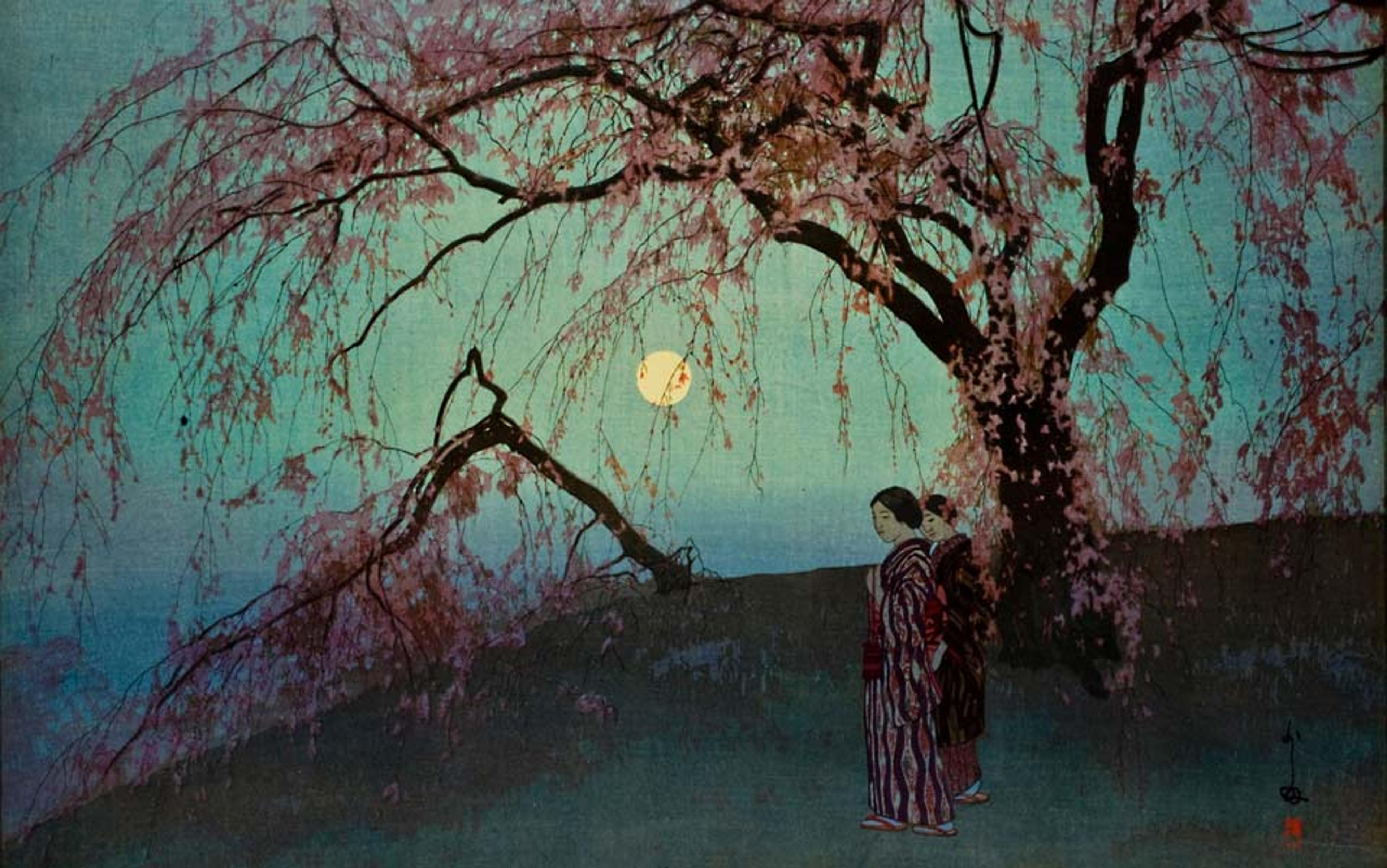
Detail from Kumoi Cherry Trees (Kumoi sakura) by Yoshida Hiroshi, 1926. Courtesy Wikemedia Commons
Today, many environmentalists feel squeamish about conservation campaigns that generate sympathy by using sublime imagery of ancient forests or charismatic animals such as pandas. There are good reasons for this turn. Mere aesthetics can no longer form the basis of a wide moral responsibility to the environment: beauty is too reliant on the cultural and historical values of human societies. In the past, environmentalists have failed to appreciate the ecological significance of subjectively ugly, or simply less visible, life forms, processes and biospheres. Contemplation was once the foundation of conservation, which consisted largely of the perpetual, and often expensive, stewardship of wild and beautiful places. Now we recognise that the inhabitable future is much more likely to turn on (invisible) atmospheric climate change, intimately woven into human economic behaviour and the atmospheric chemistry of the globe. Meanwhile, the ecological importance of places once deemed ugly, such as ‘foul’ swamplands, is well-established.
We have come to consider unbeautiful nature deserving of attention (and potentially, of preservation) and the process has dialled up scepticism about ‘natural’ beauty more generally. The bouquet of cut flowers gives away nothing of the stooped labour required to cultivate it, nor the agrochemicals that prolong unblemished blooms, the emissions generated by transportation and refrigeration, or the species supplanted by commercial hothouses. The sublime landscape, emptied of people, does not tell of the evictions required to create a nature reserve. To equate the beautiful with the good is to disregard how beautiful things come to be. According to its critics, this is beauty’s insidious underside: how beauty is normalised as apolitical and even trivial, when in fact it is neither.
What grounds most modern, mainstream green movements is not an investment in environmental mythos, natural majesty or animistic re-enchantment with beautiful sites and life forms. Instead, appeals are made to the ecological mindset — to the way that we think of ourselves as integrated in material systems of natural objects and habitats.
The ethics of caring for a tree, then, does not rest on an idea of that tree as beautiful, singular, or symbolically charged with local meaning. Instead, a tree’s value is pegged to its functionality in a biome: as the ‘lungs’ of the world, or a dwelling place for endangered species; as a means of erosion control, a limitation on urban sprawl, carbon storage, or a watershed service. Which is to say, the popular criteria for care are scientific and quantifiable. Known as natural capital, such criteria have little to do with any loose consensus about the social history of trees (and human/tree relationships) in the places that they grow.
Petitions to beauty are still made, of course, but now they invoke economics. Trees are valuable because they generate tourism or trade; connoisseurs of natural beauty are recast as financial concerns. Such people include hikers and sightseers, but also those who buy property (‘tree-changers’), and anyone who has read The Lorax by Dr Seuss to a child. Trees matter, in this context, not because they are beautiful but because certain people think they are — and those people will directly, or indirectly, contribute to the value of those trees, so long as they are not replaced by, say, car parks.
Under this model, obligations to trees exist because of how other things depend upon them — the air, for instance, certain animals, the soil, or people’s economic livelihoods. Ethical regard is dependent on apprehending connectedness. So the failure to act decisively on climate change is often attributed to a failure to perceive connectedness — the connectedness of world CO2 levels to the burning of forests, for example. These material relationships are a powerful place to begin developing green consciousness. And yet: over the coming decades it will become increasingly important to link together not just physical phenomena, but to include imaginary ones as well.
Trees in the present — which exist as tangible things, photosynthesising, dropping flowers, casting shade — are coupled to the visions we have of the future, its climate, and the people who will live their lives integrated into that climate. A tree’s significance is not just environmental; it is a device of the speculative imagination. En masse, the value of trees relates directly to the premium we place on our capacity to predict the future with accuracy. The fewer trees there are, the more wildly our versions of the future are likely to veer from the reality, because a world with fewer trees is likely to experience more severe climate change. Climate scientists corroborate: the hotter world will increase in volatility, until only novelists can confidently venture their versions of the time ahead.
This kind of thinking, which starts in environmental imagination, paradoxically holds that our ethical obligations aren’t just to trees, or to an abstract standard of nature in the future — we are also obliged to imagine the societies of descendants who will populate that future. It is this potential to expand the ambit of connectedness beyond physical relationships, to what might be considered metaphysical relationships, that many Western environmentalists have relinquished.
To the credulous outsider, sakura is primarily an aesthetic experience. The blossoms are utterly captivating — as is observing the glee of other people, who pose and gaze amid the trees. The stereotype is as seductive as it is condescending: here is an innocence, we might believe, now lost to Western environmentalists, delighting in the seasons and seasonal change. The enjoyment of sakura is that of being reacquainted with the thrill of meticulous observation. How often does the opportunity to dwell on simply looking at trees present itself to the ordinary urbanite? No one thinks it peculiar in Ueno Park to bend a switch of blossom and inhale its faint perfume.
For hard-headed environmentalists, sakura might be seen as nothing more than the mawkish appreciation of natural beauty. Why talk of these common and decorative trees, when icebergs, polar bears, a dozen small types of amphibian and old-growth forests face the real possibility of extinction, in our lifetime? One might sooner look to ikebana, the Japanese custom of flower-arranging, or even bonsai — trees made miniature with tourniquets and topiary — to garner knowledge about how Japanese people engage with nature. There, at least, we see evidence of an active engagement with natural objects, and an attempt to use botany as a study of environmental relationships. Sakura, on the other hand, seems at once too passive and too sentimental to sustain fruitful analysis.
But to interpret sakura and the conventions of hanami as mere acts of aesthetic indulgence is to miss the full significance of the season. Sakura flowering is brief. To the Japanese people, the cherry-blossom season is properly understood as a contemplation of transience in human life. To celebrate sakura is to mark the fleet-footed passage of time: from the traditions of flower-viewing begun in Japan’s classical history to the embodied time of personal histories and, inevitably, individual mortality. As Motojirō Kajii exclaims in his story ‘Under the Cherry Trees’ (1928):
Dead bodies are buried under the sakura! You have to believe it. Otherwise, you couldn’t possibly explain the beauty of the sakura blossoms. I was restless, lately, because I couldn’t believe in this beauty. But I have now finally understood: dead bodies are buried under the cherry trees.
Beauty, as always, is in step with the death drive. Ultimately, it is this aspect of the sakura tradition that yokes environmental imagination to concepts of deep time, past and future. For, of course, sakura is an acknowledgement that we are each others’ environment; that our communal relationships with each other, with our social pasts and futures, determine how we value the world of trees. Sakura reinforces a set of environmental values in which people — and people’s ethical regard both for one another and for other natural objects — are central. After all, human beings were always ‘natural objects’, despite environmentalism’s focus on wild spaces, creatures and trees. In an age of systemic climate change, the grandeur and mystery of all that we call ‘nature’ is indelibly tinged by human presence. Sakura is founded on an analogous commingling of environmental and cultural information — yet it resists hubris, melancholia or sentimentality.
Leaping from branch to branch in Ueno Park are jungle crows — a heavy, large-billed Asian species of corvid — whose burgeoning population caused Tokyo’s governor in 2009 to call for crow-meat pies to become the city’s special dish. The birds shake down showers of blossom and leave the boughs bare. The season is over. Sakura’s meditations on human transience bond the Japanese people tightly to those future generations whose claim on the experience of cherry trees will be not just seasonal, but perpetual. Behind the beauteous enjoyment of these flowers lies an appreciation of environmental imagination we would do well to recoup.
